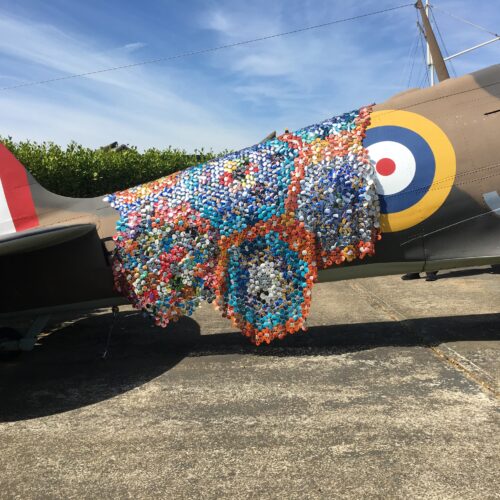
The Body Beautiful
Women’s social identity has long been conditioned by their culture’s perception of their bodies. The criteria, obsessions and preoccupations according to which women construct their appearance, vary over time, but as a trio of current exhibitions show, assumptions about beauty, body image, and fashion can be explored and challenged in surprising ways.
One of the central themes in the Fitzwilliam Museum’s Silent Partners exhibition, devoted to the artist’s mannequin (or lay figure), is the notion of perfection of the artificial figure – and the human body. The fashion mannequins on display, which evolved in little more than a generation from being upholstered human replicas to becoming sleek, abstract artistic creations, are idealised, stereotyped and manipulated props of commerce, but they also reveal the narrow gap between real and imagined figures. We all construct and manipulate our bodies. The silenced female figures in this show seem to point to the ways in which men, in their desire to control, make models of women to embody the gaze; they look at women who, at last, will behave themselves.
More disturbing work involving dolls can be seen at the Royal Academy, as it appraises the career of British Pop artist Allen Jones. Obsessed with the female figure, fakery and fetish, Jones is perhaps best known for his controversial woman-as-object sculptures Hat Stand, Table and Chair. New works, including Body Armour, in which a mannequin-like Kate Moss appears in a bionic bronze glittery body-suit, guarantee further feminist critique, but in looking at how we project constructed views of ourselves, and at how men think about women, Jones is also exploiting the representation of the sexually available female that has existed since the time of Titian.
One such representation, often understood to be an arousing ‘pin up’, is the 1545 image Venetian Women at their Toilet by Titian’s pupil Paris Bordon, which plays a key role in the Scottish National Portrait Gallery’s exhibition Beauty by Design: Fashioning the Renaissance. A collaboration between fashion designers, stylists, artists, curators and art historians, the show brings together a new body of work that has been informed by Renaissance paintings in the Gallery’s collection (such as the portrait of Margaret Graham, Lady Napier, by Adam de Colone). It also reconsiders the ‘thin ideal’ of airbrushed teenage models with their altered body proportions and plasticised skin, so dominant in contemporary media and fashion.
One of the highlights of the display is Mal Burkinshaw’s series of jackets (the product of a close collaboration with renowned French lace producers Sophie Hallette), which fuses Renaissance and contemporary fashions to challenge past and present notions of, and attitudes to, ‘normalised’ body shapes. The jackets, which do not conform to standard UK size measurements and are non-gender specific, invite us to question our perceptions of beauty relating to body size. Rather than subjecting our bodies to what Sandra Lee Bartky has termed the “tyranny of slenderness” via the imposition of disciplinary practices such as diet and exercise, the exhibition stresses the potential to improve self-esteem through the promotion and reinstatement of a healthier, more diverse and ‘emotionally considerate’ attitude towards fashion design.
Not that the Renaissance ideal of beauty and the discipline involved in its production was any less gruelling for sixteenth-century women than the pursuit of size zero is today. A voluptuous model of feminine beauty (which would now be considered fat) was promoted, but then as now, beauty followed a formula. Women went to a great deal of trouble and expense to make their appearance conform to standards that remained virtually unaltered throughout the early modern period. In Italy, France, Spain, Germany, and England the basic aesthetic was the same: white skin, long and wavy blonde hair, red lips and cheeks, black eyebrows, supple waist. Poems in honour of individual women would describe them in terms of this aesthetic norm, and women themselves turned to cosmetics, corsets, and high-heeled shoes to conform to the current canon.
There is nothing new in women’s preoccupation with youth and beauty, in their feeling compelled to make themselves objects for the male gaze, or in their pervasive sense of bodily deficiency. However, as these exhibitions demonstrate, what is new is the growing power of the image in a society increasingly orientated toward the visual media. Which begs the question – is it too late to change how the idea of beauty is communicated?
Silent Partners: Artist & Mannequin from Function to Fetish, until 25 January 2015, Fitzwilliam Museum, Cambridge (We are running a Study Visit to this exhibition on the 24 January.)
Allen Jones RA, until 25 January 2015, Royal Academy of Arts, London
Beauty by Design: Fashioning the Renaissance, until 3 May 2015, Scottish National Portrait Gallery, Edinburgh
Image credits:
Paul Huot, Female Mannequin, c. 1816, Museumslandschaft Hessen Kassel, Sammlung Angewandte Kunst © bpk – Bildagentur für Kunst, Kultur und Geschichte / Museumslandschaft Hessen Kassel
Allen Jones, Body Armour, 2013. London, Private Collection. Image courtesy of the artist. © Allen Jones
Mal Burkinshaw, Tailored Jacket, from Silhouettes en Dentelle – Series 1, 2013-14. © Mal Burkinshaw









Artist Hye Rim Lee tackles the question of how woman are presented today in visual media especially on the internet and in computer games. Her works highlight the presentation of the female form in visual media. Viewing her works makes you realise the damaging impact of the internet which actively promotes, with seemingly no restrictions, women as sexual objects. This seemingly unmonitored depiction of the figure undoes hard fought work over the years of people trying to change the way women are presented.